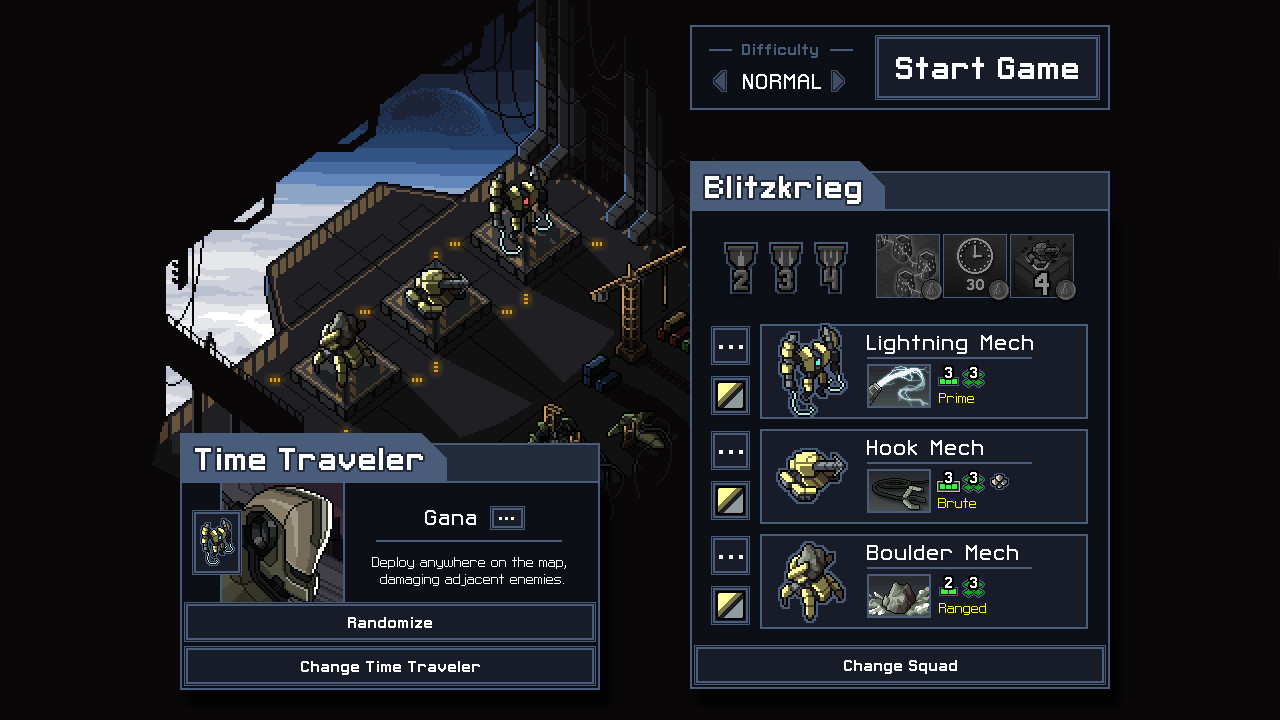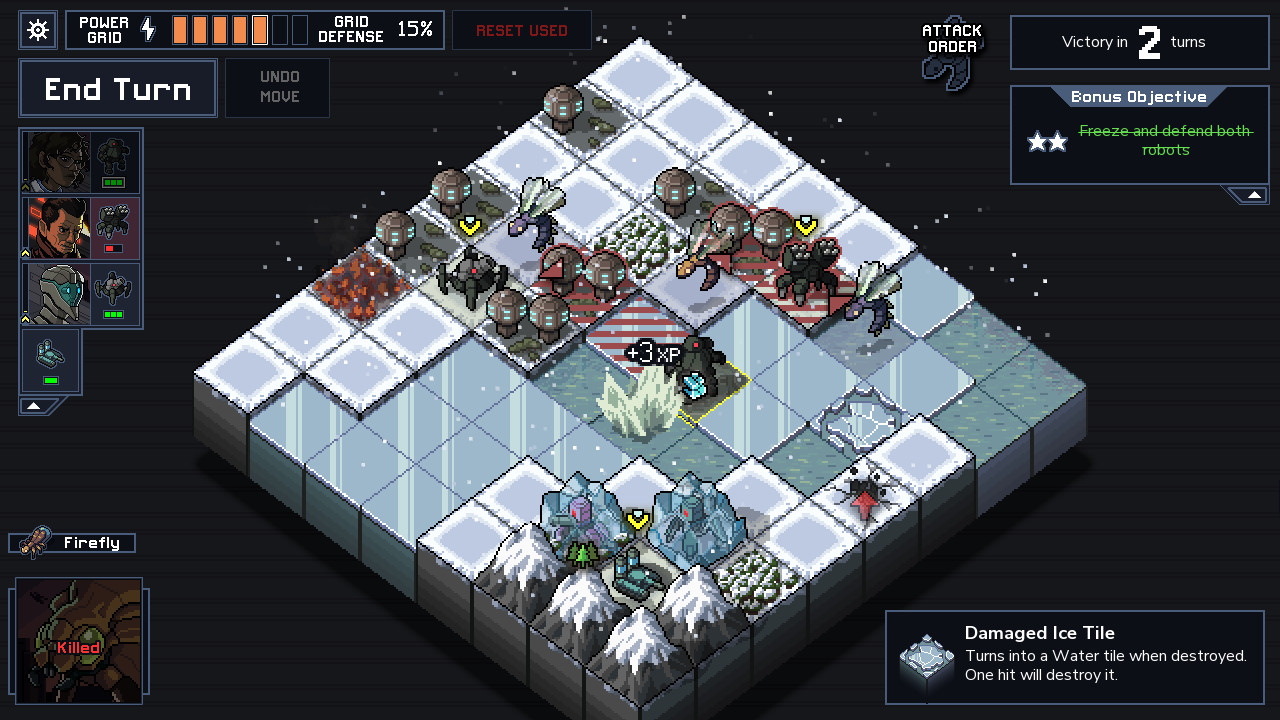Back in 2012, when Subset Games launched FTL, it was one of those moments that took the indie scene by storm, it was a market hit that inspired many more games. Hopefully, with Into the Breach, history will repeat itself.
Type: Single-player
Genre: Simulation, Strategy
Developer: Subset Games
Publisher: Subset Games
Release Date: 27 Feb, 2018


The premise of the game is pretty interesting, and, the more I played, the more I found myself considering the consequences of my actions, even though as far as gameplay goes there are no actual consequences. The player takes control of a squad of three mechs and their pilots, as they’re traversing into different timelines, in order to save Humanity from the Vek threat. In doing so, you’re bound to lose countless times but, no matter how many times you succeed, there are always other timelines in which you haven’t saved the world. This is how the game ties it’s highly replayable nature to the world and setting since whether you fail or succeed, you always end up opening a breach into another timeline and attempting to save that one.
The game features turn-based combat as its core, with several persistent progression elements also in place in order to try and keep people engaged in the long run. The game only gives you access to one mech squad at the beginning, and you have to rely on that one to make any actual progress and complete achievements, because achievements grant you coins, which you can then use to unlock the other seven mech squads. Likewise, there is also a small roster of pilots that you’ll be able to unlock by finding them during your runs, and these also allow you to come up with different strategies as you play, and most often than not they’re also more effective with certain squads.

The combat is really the heart and soul of the game, and while I did describe it as actual turn-based combat, the game also feels most like a puzzle game, and, to some extent, even chess. The missions take place in an 8×8 board of square tiles, but you can’t move through all of these, some have structures that you need to protect, and others have certain geographical features that bring along some dynamics to the actual combat. For instance, forests can be set on fire if fired upon, you can drown the Vek by pushing to a water tile, there’s acid that doubles the damage taken, mountains that provide cover, ice that freezes units and shields buildings, and smoke that prevents units from attacking.
Even though Into the Breach excels at many things, if there’s one thing that really stands out as far as combat goes, and which paves the way for an extremely compelling gameplay experience is the fact that you can see what each enemy is going to do in the next turn. Very much in the same way as to how you can see what enemies will do in the next turn, you can also see where enemies will spawn, and you can even stave off their spawn by placing a unit on the same tile, at the cost of some health. Being able to choose where your units deploy at the beginning of a battle can also have a very strong impact in the outcome of the first few turns since the amount of tiles that each unit can move varies from one to another.

The fact that you can see enemy attacks before they actually happen adds a whole new layer of strategy and planning that I don’t think that I have ever seen in a turn-based tactics game before. The various squads at your disposal are also not mere variations of each other or simple reskins, each mech type from each squad plays and behaves extraordinarily different from the rest. While the Flame Behemoths focus on setting everything on fire, the Hazardous Mechs deal damage to themselves when they attack and only heal by killing Vek, and the Steel Judoka try to manipulate enemy positioning to their advantage by forcing them to attack each other. The arsenal at your disposal is plentiful, you’ll be able to equip new weapons and upgrade your mech along each run, which in turn also allows you to come up with even more insane and daring strategies.
There are a lot of different things that can happen at the same time when you’re on a mission, and they can be both good or bad depending on the occasion. While eliminating the enemies sounds like a thing that one should do in a game like this, in this game that’s actually not entirely necessary, sure it helps, but the gameplay focuses on more than that. In each mission, your objective is to hold out until the enemy retreats while also protecting buildings from taking damage. The buildings are connected to a power grid, one that keeps you running, so you can only take a certain amount of hits before you see yourself forced to open a time breach and try again.
This might sound like just an interesting way that the developers have come up with instead of using a boring health bar, but in reality, it’s actually much more than that. The damage that is done to your power grid persists across missions, and there’s also a chance that buildings might resist damage, so this creates a whole new series of gameplay opportunities for the players. Sometimes it’s simply not possible to score a perfect battle, something has to be sacrificed, a mech, a building full of civilians, or a bonus objective that you’re given during a mission, and it’s up to the player to decide what they’re willing to let go. Nonetheless, you can always repair your power grid after clearing an island, provided you completed any optional objectives during each mission.
The game is structured in a way that there are four islands that you can clear before proceeding to the final fight, even though you only need to clear two of them before being able to go straight for the final one. Since difficulty scales with how much you’ve progressed in each run, facing this last mission after securing only two or all four islands doesn’t mean that you’ll end up having an easier time. However, attempting to secure more islands will allow you save more civilians, hopefully, which will increase your overall score at the end of the run. In the end, it’s really up to the player to decide if they’re feeling like getting a bit more geared up, or attempt to complete the run while the enemies are not as tough as they could be. However, these islands are very different, each presents specific challenges and objectives, so it’s up to the player to choose the order in which they want to approach them.

Verdict
Overall, it’s very clear that there’s quite a fair bit of randomness which you have no control over, and this, much like in FTL, can both act in your favor or not. Each battle feels like a puzzle, and it’s up to you to find the best way to solve it, and this doesn’t mean it has to be perfect, there are sacrifices to be made. This is a game that feels much more reliant on patience than on actual player skills, and it shows. With that said, the game is bound to become repetitive, eventually. Fortunately, this is a good kind of repetitive.
Into the Breach offers an extremely compelling gameplay loop, that neatly ties itself together not only gameplay wise but also in terms of context. Thanks to the game’s masterful UI and the inclusion of different difficulty modes, which is sure to please different audiences, the only actual barrier to entry is lack of experience when it comes to this title. At the end of the day, there is really only one thing that makes me feel a bit bummed down, and that’s the repetitive music that you constantly hear during combat. Other than that, all I can say is that Into the Breach is a fresh and addictive turn-based combat game, and it’s clearly among my favorite games of this year.











